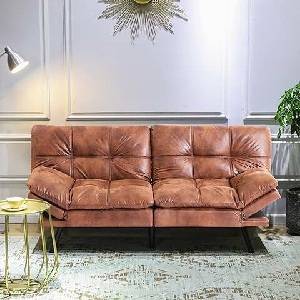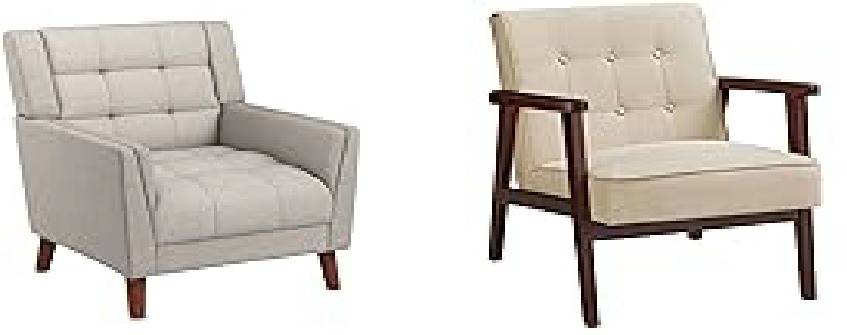Table of Contents
ToggleIntroduction:
Transforming a small living room into a functional, stylish space can feel like a daunting task. Yet, with the right strategies and a touch of creativity, you can maximize your living area, making it appear larger and more inviting. This comprehensive guide will walk you through the steps and tips to arrange living room furniture in a small space effectively, ensuring every inch is utilized without compromising on style or comfort.
First you need to know which Small Living Room Furniture
When it comes to arrange Living Room Furniture in a Small Space, choosing the right pieces is essential. Here are some types of furniture that work well in small spaces:
Sofas and loveseats are staple pieces of living room furniture, providing comfortable seating for lounging and entertaining. In small living rooms, opt for compact designs with clean lines to prevent overcrowding.
Armchairs and Accent Chairs
Adding armchairs or accent chairs to your small living room provides additional seating without taking up too much space. Choose chairs with slender profiles and open bases to maintain an airy feel.
Coffee Tables and Side Tables
Coffee tables and side tables are not only practical for holding drinks and snacks but also serve as decorative accents in your living room. Look for tables with slim silhouettes and built-in storage to maximize functionality.
Console Tables
Console tables are versatile pieces of furniture that can be used for storage, display, or as a makeshift desk in a small living room. Opt for narrow designs that can be placed against a wall to save space.
Ottomans and Poufs
Ottomans and poufs are excellent space-saving solutions that can serve as extra seating, footrests, or even makeshift coffee tables when topped with a tray. Choose designs that can be tucked away when not in use to free up floor space.
Folding and Nesting Furniture
Folding and nesting furniture are ideal for small living rooms as they can be easily tucked away when not in use, freeing up valuable floor space. Consider investing in folding chairs or nesting tables that can be stored compactly when not needed.
Wall-mounted Shelves
Wall-mounted shelves are excellent space-saving solutions that provide additional storage without taking up floor space. Use them to display decorative items, books, or plants, and consider incorporating floating shelves for a modern look.
Modular furniture allows you to customize your living room layout according to your needs and preferences. Choose modular sofas or shelving units that can be rearranged to adapt to different situations, providing flexibility in a small space.
Tips for Arranging Living Room Furniture
Arranging furniture in a small living room requires careful planning to maximize space and functionality. Here are some tips to help you make the most of your limited square footage:
Assessing the Space
Before diving into furniture arrangement, it’s essential to assess the dimensions and layout of your living room. Measure the space accurately, including doorways, windows, and any architectural features. Identifying focal points, such as a fireplace or large window, will help you plan the layout effectively.
Embrace Vertical Space
Don’t neglect the vertical space in your living room. Tall bookcases, wall-mounted shelves, and artwork can draw the eye upwards, making the room feel larger. This strategy also provides additional storage and display options.
Placement Strategies for Maximizing Space
When arranging furniture, think vertically to make the most of limited floor space. Consider wall-mounted shelves or tall bookcases to provide storage without taking up valuable square footage. Create distinct zones within the room for different activities, such as seating areas and entertainment zones, to maximize functionality.
Tricks to Create the Illusion of Space
Incorporate design elements that visually expand the room. Strategic lighting, such as recessed fixtures or pendant lamps, can brighten up the space and make it feel larger. Mirrors and reflective surfaces can also create the illusion of depth and openness by bouncing light around the room.
Choose a Focal Point
Every living room needs a focal point, whether it’s a window, fireplace, or a piece of art. Arranging your furniture around this focal point not only adds character but also organizes the space more effectively, guiding your design decisions.
Creating Zones
Divide your Arrange Living Room Furniture into functional zones, such as a seating area, entertainment zone, and workspace, to optimize space and organization. Use area rugs or furniture placement to delineate each zone and create visual separation.
Decorating Ideas to Enhance Small Living Room Furniture
In addition to choosing the right furniture, incorporating thoughtful decor can help enhance the look and feel of your small living room. Here are some decorating ideas to consider:
Choosing the Right Furniture
Investing in the right furniture pieces is crucial for small living rooms. Look for multi-functional items like sleeper sofas or ottomans with hidden storage compartments. Opt for space-saving designs, such as armless chairs or nesting tables, that can easily be tucked away when not in use.
Invest in Multi-functional Furniture
In small spaces, versatility is key. Opt for furniture that serves multiple purposes, such as a sofa bed for guests or an ottoman with storage. These pieces save space and reduce clutter, making your living room more functional.
Add Rugs to Define Areas
Rugs are a powerful tool in defining different areas within your small living room, especially if you’re working with an open-plan space. A well-placed rug can delineate the living area from a dining space or entryway, creating a sense of organization and flow.
Choosing the Right Color Palette
Selecting the right color palette can make a significant difference in the perceived size of your living room. Opt for light, neutral colors on the walls and furniture to create an airy feel and make the space appear larger. Add pops of color with accessories and accent pieces for visual interest.
Using Mirrors to Create Illusions of Space
Mirrors are a powerful tool for visually expanding small spaces by reflecting light and creating the illusion of depth. Hang a large mirror opposite a window to maximize natural light and make the room feel brighter and more spacious.
Implement Smart Storage Solutions
Clutter can quickly consume a small living room, making it feel cramped. Utilize smart storage solutions like floating shelves, hidden storage, or slimline media units to keep the room tidy and organized.
Tips for Traffic Flow and Accessibility
Ensure that there’s enough room for comfortable movement throughout the living room. Leave adequate space between furniture pieces to allow for smooth traffic flow and easy access to seating areas. Avoid placing furniture directly in front of doorways or blocking pathways to maintain accessibility.
Styling and Decor Ideas for Small Living Rooms
When it comes to decor, less is often more in small spaces. Opt for light-colored walls and furniture to create an airy and open feel. Choose minimalist designs with clean lines to prevent the room from feeling overcrowded. Incorporate storage solutions, such as floating shelves or storage ottomans, to keep clutter at bay.
Arrange Furniture for Conversation
Your living room should invite conversation. Arrange seating in a way that encourages people to face each other. A U-shape or L-shape layout works well, ensuring everyone in the room can easily interact.
Light It Up
Proper lighting can significantly impact the ambiance and functionality of a small living room. Incorporate a mix of ambient, task, and accent lighting to illuminate the space effectively. Maximize natural light by keeping window treatments minimal and opting for sheer curtains or blinds. Supplement natural light with overhead fixtures, table lamps, and wall sconces to create a warm, inviting atmosphere that enhances the overall aesthetic of the room.
Add Personal Touches
Lastly, don’t forget to infuse your personality into the space through decorative accents and personal touches. Whether it’s a gallery wall of cherished photos, a collection of unique trinkets, or vibrant throw pillows, adding personal elements will make your living room feel like home. Just remember to strike a balance between clutter and character to maintain a cohesive and inviting space.
Conclusion:
Arranging living room furniture in a small space doesn’t have to be a challenge. By following these tips, you can create a functional, stylish space that feels open and welcoming. Remember to understand your space, choose multi-functional furniture, utilize smart storage solutions, and embrace natural light. With a bit of creativity and strategic planning, your small living room can become a cozy, inviting area that meets your needs and reflects your personal style. Remember, the key to a successful small living room design is not just about fitting everything you need; it’s about doing so in a way that feels spacious, comfortable, and uniquely yours.
FAQs
- Can I use large furniture in a small living room?
- While it’s possible, it’s best to opt for scaled-down furniture pieces to avoid overwhelming the space.
- How can I make a small living room look bigger?
- Incorporating mirrors, strategic lighting, and light-colored decor can help create the illusion of space.
- What are some multi-functional furniture options for small living rooms?
- Sleeper sofas, storage ottomans, and nesting tables are excellent choices for maximizing functionality in small spaces.
- Should I avoid rugs in a small living room?
- Rugs can add warmth and texture to the space, but it’s best to choose a size that doesn’t overwhelm the room.
- How can I maintain a sense of cohesion in a small living room with diverse furniture pieces?
- Stick to a cohesive color palette and style to create a harmonious look, even with different furniture pieces.










